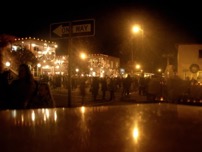“Broken Arrow Roasters”
I started drinking coffee around the time Kristin and I began dating. We would often spend an evening at Caribou Coffee on Mack Ave. on the east side of Detroit. Leslie Fredericks and her buddy Kenny performed live folk music once a week, and we tried to make it often. I progressed rapidly from hot chocolate to mocha cappuccino, and then on to caffe latte. I bought my own coffee maker. Then a grinder so I could use whole beans. An obsession had begun. When we lived in Chicago, I bought beans from Equal Exchange (www.equalexchange.coop). Their fair trade coffee was so good! Much better than the stuff at the grocery store or coffee houses like Starbucks or Caribou. I became interested in where coffee comes from, how it’s produced, and what makes great coffee.
These days, I buy my beans unroasted (“green”) from Sweet Maria’s in Oakland, CA (www.sweetmarias.com). I use a Behmor 1600 drum roaster on my back patio to roast fresh beans every few days. The difference is amazing! Freshly roasted beans make terrific coffee, and now I can finally understand what coffee people mean when they describe exotic flavors like blackberry, orange rind, bergamot, chocolate, or citrus in their coffee. You just can’t get that from beans that were roasted weeks or months ago.
Fresh-roasted beans also make terrific iced coffee! In the summer I cold brew coffee in our refrigerator. All it takes is a french press, coarsely ground beans, and water. Leave it in the fridge overnight, and the next day, you can pour out a jar full of concentrated coffee. By doing it without heat, the resulting coffee is very flavorful and not at all bitter like hot coffee. It’s more like a very strong, very complex iced tea. Fill a glass about an inch deep with coffee and another two with milk, drop in a cube or two of ice, and you have a terrific outdoor refreshment for hot summer days.
Believe it or not, roasting beans at home is less expensive than quality beans from the supermarket or coffee shop. Much of the profit in roasted beans comes from the roasting stage of production. Doing it myself, I spend about 20% less on really good coffee beans compared to Starbucks or other specialty roasters. We use enough coffee that the roaster paid for itself in about a year.
I’ve been sharing these fresh-roasted beans with family and friends, teachers and coaches, especially as gifts, under the label “Broken Arrow Roasters.” (Our home is on Broken Arrow Lane.) One day, I’d love to try selling some at one of the local grower’s markets just to see what people think and whether there’s interest. The Behmor won’t cut it as a commercial roaster, but I’ve learned a lot from it about different roasts and “origin flavors,” the unique flavor profiles of beans from specific countries, regions, and even individual crops.





